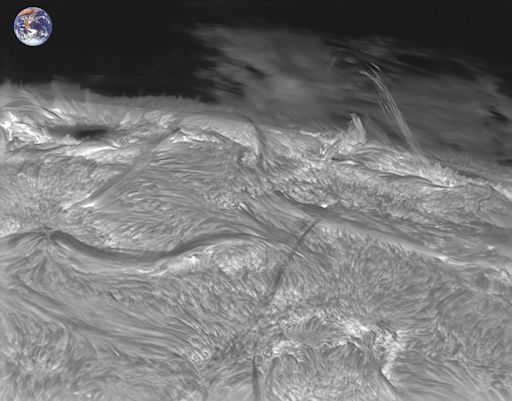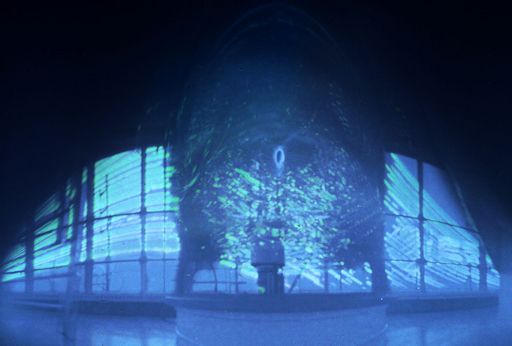When is the best time to see auroras? Where is the best place to go? And how do you photograph them? These questions and more are answered in a new book, Northern Lights - a Guide, by Pal Brekke & Fredrik Broms. | | | HARSH SPACE WEATHER DOOMS LIFE ON RED DWARF PLANETS: Red dwarfs are by far the most numerous type of star in the Galaxy, accounting for as much as 80% of the stellar population of the Milky Way. Because of this, astronomers looking for potentially habitable worlds have targeted red dwarf stars. A new study, however, shows that harsh space weather might strip the atmosphere of any rocky planet orbiting in a red dwarf's habitable zone, dooming life as we would know it in a majority of the Galaxy's planetary systems. [full story] SOLAR ACTIVITY: With several active sunspots rotating over the sun's western limb, departing for the farside, solar activity is quieting. The departure, however, is a riot. J. P. Brahic sends this picture from Uzès, France: 
Brahic inserted an image of Earth for scale. The dark cores of the departing sunspots are about the size of our planet, and the surrounding tangle of magnetic filaments could swallow Earth with room to spare. Brahic took the picture through cirrus clouds using a 9 inch solar telescope. These sunspots are leaving behind at least one region still capable of major flares: AR2087 is almost directly facing Earth and it has a 'beta-gamma' magnetic field that harbors energy for M-class eruptions. Any flares from AR2087 this weekend would hit Earth head on. Solar flare alerts: text, voice Realtime Space Weather Photo Gallery TIME TO CHECK YOUR SOLARCANS: The northern summer solstice is just one week away. According to Jan Koeman of Philippus Lansbergen Observatory in Middelburg,the Netherlands, that means "it's time to check your solarcans." A solarcan, a.k.a. solargraph, is a pinhole camera made from a soda or beer can lined with a piece of photographic paper. Using such a simple device, it is possible to take extraordinarily long exposures of the daily sun--in this case, six months long. Yesterday, Koeman opened a solarcan he deployed in December, and this is what he found: 
Normally, solarcans record the graceful tracks the sun makes across the sky as the seasons unfold--high tracks corresponding to summer, low tracks to winter. In this case, the tracks were interrupted because Koeman deployed his solarcan inside a lighthouse. "I worried that the powerful light from the lighthouse would overwhelm the sun. Luckily our sun is much stronger. However, the fresnel prisms in the lighthouse were chopping up the sunlight." Got a solarcan? Open it up and submit your images. 6-month Solargraph How-to Guides: #1, #2, #3 Realtime Space Weather Photo Gallery
Realtime Aurora Photo Gallery
Realtime Comet Photo Gallery
Realtime Meteor Photo Gallery
Every night, a network of NASA all-sky cameras scans the skies above the United States for meteoritic fireballs. Automated software maintained by NASA's Meteoroid Environment Office calculates their orbits, velocity, penetration depth in Earth's atmosphere and many other characteristics. Daily results are presented here on Spaceweather.com. On Jun. 15, 2014, the network reported 5 fireballs.
( 5 sporadics)  In this diagram of the inner solar system, all of the fireball orbits intersect at a single point--Earth. The orbits are color-coded by velocity, from slow (red) to fast (blue). [Larger image] [movies] Potentially Hazardous Asteroids ( PHAs) are space rocks larger than approximately 100m that can come closer to Earth than 0.05 AU. None of the known PHAs is on a collision course with our planet, although astronomers are finding new ones all the time. On June 15, 2014 there were 1483 potentially hazardous asteroids. Notes: LD means "Lunar Distance." 1 LD = 384,401 km, the distance between Earth and the Moon. 1 LD also equals 0.00256 AU. MAG is the visual magnitude of the asteroid on the date of closest approach. | | The official U.S. government space weather bureau | | | The first place to look for information about sundogs, pillars, rainbows and related phenomena. | | | Researchers call it a "Hubble for the sun." SDO is the most advanced solar observatory ever. | | | 3D views of the sun from NASA's Solar and Terrestrial Relations Observatory | | | Realtime and archival images of the Sun from SOHO. | | | from the NOAA Space Environment Center | | | the underlying science of space weather | | 
